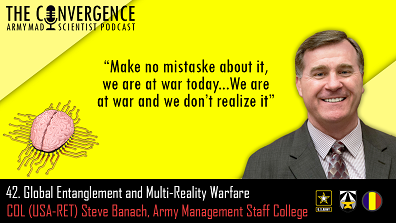[Editor’s Note: Army Mad Scientist is pleased to feature today’s episode of The Convergence podcast with COL Stefan Banach (USA-Ret.), Director, Army Management Staff College, discussing global entanglement, multi-reality warfare, and the urgent need for a new paradigm and cognitive approach to warfare for the U.S. Army and larger Joint Force — Enjoy! (Please note that this podcast and several of the embedded links below are best accessed via a non-DoD network due to network priorities for teleworking)]
[If the podcast dashboard is not rendering correctly for you, please click here to listen to the podcast.]
 COL Stefan Banach (USA-Ret.) is a Distinguished Member of the 75th Ranger Regiment and served in that organization for nine years, culminating with command of the 3rd Ranger Battalion from 2001-2003. He led U.S. Army Rangers during a historic night combat parachute assault into Afghanistan on October 19, 2001, as the “spearhead” for the Global War on Terror. Steve subsequently led U.S. Army Rangers in a second combat parachute assault into Al Anbar Province in western Iraq in 2003. He served with distinction in the United States Army from 1983 to 2010. Since then, he has provided executive consulting services to a diverse range of clients at a number of prestigious institutions. Steve Banach also serves as the Director, Army Management Staff College, an element of Army University responsible for “igniting the leadership potential for every Army civilian.”
COL Stefan Banach (USA-Ret.) is a Distinguished Member of the 75th Ranger Regiment and served in that organization for nine years, culminating with command of the 3rd Ranger Battalion from 2001-2003. He led U.S. Army Rangers during a historic night combat parachute assault into Afghanistan on October 19, 2001, as the “spearhead” for the Global War on Terror. Steve subsequently led U.S. Army Rangers in a second combat parachute assault into Al Anbar Province in western Iraq in 2003. He served with distinction in the United States Army from 1983 to 2010. Since then, he has provided executive consulting services to a diverse range of clients at a number of prestigious institutions. Steve Banach also serves as the Director, Army Management Staff College, an element of Army University responsible for “igniting the leadership potential for every Army civilian.”
In our interview with Steve Banach, we discussed global entanglement, multi-reality warfare, and the urgent need for a new paradigm and cognitive approach to warfare for the U.S. Army and larger Joint Force. The following bullet points highlight key insights from our interview:
-
-
- The U.S. military needs to develop a ‘fourth Army,’ whose form and function are capable of gaining logic from disorder. This Army will be better prepared to operate in the multi-reality, technologically integrated battlespace that is already upon us.
-
-
-
- The next war will be characterized by operations within the virtual battlespace. To prepare for this phase of warfare, the U.S. Army needs to develop new mental models to understand the vulnerabilities that arise from an increasingly interconnected world. Such an effort should feature the development of a ‘virtual battlespace maneuver doctrine.’
-
-
-
- Our adversaries are working to integrate technologies from autonomous weapons systems to social media to dominate this new battlespace. Future adversaries will not always be on a physical battleground, but the impacts of their operations will be felt both by the U.S. military and civilian population as they seek to create systemic shock and paralysis. The Army should redevelop its total force design and increase its operational arc to prepare the United States for this new form of conflict.
-
-
-
- Weapons of ‘mass deception’ will be increasingly prevalent in conflict, as social media is manipulated to prevent population education and engagement with critical issues. The United States should increase awareness of this threat via programs in both civilian and military education.
-
-
-
- Asymmetric ethics in the virtual battlespace will necessitate the development and communication of zones of acceptability and limits of tolerance. These standards should be accompanied by specific response outlines to both deter and defend against enemy attacks in this sphere.
-
-
-
- Our adversaries capitalize on global entanglement and multi-reality warfare by creating dependence on connectivity, increasing surveillance of online networks, and using data collected to understand and manipulate the population. This strategy involves technologies from FitBits to biometric scanners and takes advantage of a world in which every individual has an online presence.
-

Stay tuned to the Mad Scientist Laboratory for our next episode of The Convergence — A New American Way of Training — featuring Jennifer McArdle, Product Strategist at Improbable and Adjunct Senior Fellow at the Center for a New American Security, discussing the future of the Synthetic Training Environment, flexibility and scalability in training systems, and the critical need for a new agile approach to training that can keep pace with the dynamic character of warfare.
If you enjoyed today’s post and podcast, check out the following related content:
The Future of War is Cyber! by CPT Casey Igo and CPT Christian Turley
A House Divided: Microtargeting and the next Great American Threat, by 1LT Carlin Keally
Nowhere to Hide: Information Exploitation and Sanitization
The Exploitation of our Biases through Improved Technology, by Raechel Melling
LikeWar — The Weaponization of Social Media
The Death of Authenticity: New Era Information Warfare
Influence at Machine Speed: The Coming of AI-Powered Propaganda by MAJ Chris Telley
Damnatio Memoriae through AI and What is the Threshold? Assessing Kinetic Responses to Cyber-Attacks, by proclaimed Mad Scientist Marie Murphy
Sub-threshold Maneuver and the Flanking of U.S. National Security, by Dr. Russell Glenn
The Erosion of National Will – Implications for the Future Strategist, by Dr. Nick Marsella
Weaponized Information: What We’ve Learned So Far…, Insights from the Mad Scientist Weaponized Information Series of Virtual Events, and all of this series’ associated content and videos [access via a non-DoD network]
Weaponized Information: One Possible Vignette and Three Best Information Warfare Vignettes



